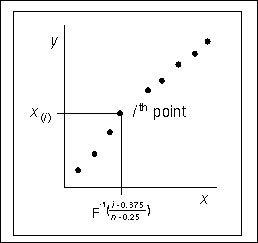QQPLOT Statement: CAPABILITY Procedure
Construction of Quantile-Quantile and Probability Plots
Figure 5.43 illustrates how a Q-Q plot is constructed. First, the n nonmissing values of the variable are ordered from smallest to largest:
![]()
Then the ith ordered value ![]() is represented on the plot by a point whose y-coordinate is
is represented on the plot by a point whose y-coordinate is ![]() and whose x-coordinate is
and whose x-coordinate is ![]() , where
, where ![]() is the theoretical distribution with zero location parameter and unit scale parameter.
is the theoretical distribution with zero location parameter and unit scale parameter.
Figure 5.43: Construction of a Q-Q Plot

You can modify the adjustment constants –0.375 and 0.25 with the RANKADJ= and NADJ= options. This default combination is recommended by Blom (1958). For additional information, refer to Chambers et al. (1983). Since ![]() is a quantile of the empirical cumulative distribution function (ecdf), a Q-Q plot compares quantiles of the ecdf with quantiles
of a theoretical distribution. Probability plots (see PROBPLOT Statement: CAPABILITY Procedure) are constructed the same way, except that the x-axis is scaled nonlinearly in percentiles.
is a quantile of the empirical cumulative distribution function (ecdf), a Q-Q plot compares quantiles of the ecdf with quantiles
of a theoretical distribution. Probability plots (see PROBPLOT Statement: CAPABILITY Procedure) are constructed the same way, except that the x-axis is scaled nonlinearly in percentiles.
